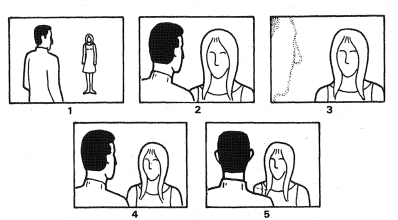Interviews
This is probably the commonest type of situation on TV, and appears in one form or another many times a day.
In the studio
While guest(s) are being received, the director is setting up shots in the studio, and briefing the crew.
Typically, ‘stand-ins’ (e.g. crew) sit in the chairs while shots, lighting and sound are checked. Chair positions are marked on the floor (chalk or tape). The guests take their places, and chat with the interviewer while the sound engineer checks voice levels. Camera operators should look out for any signs of idiosyncrasies; any tendency to lean back or forward, make wide arm movements, etc.
Directors have different approaches to interviews:
• Discussion before the studio, then a single recorded take of the required duration.
• A long continuous take, from which highlights are extracted.
• A take of the required duration; retaking unsatisfactory sections.
• What is virtually two separate interviews with a break between, the final show being edited from them both.
The method adopted may be varied to suit the temperament of the guest, how quickly they settle down, whether there are repetitive or uninteresting passages, etc., and the time available.
Rehearsal can produce spontaneity. While it gives confidence to some, it causes others to omit, repeat or change information. Some guests need patient coaxing; others are hard to stop.
Ensure that the guest has seen in advance any film or tape inserts being referred to. It is often best if nearby picture monitors show only these inserts. Many people find shots of themselves distracting or preoccupying.
Location interviews
An inexperienced guest feels most at ease when interviewed at their home or work place. Studio surroundings seem artificial and unfamiliar.
One regular technique is to have the interviewer out of picture (unheard), while the camera concentrates on the guest – zooming to vary the shot Wherever possible avoid lengthy interviews with a hand-held or shoulder-supported camera.
After theinterview is complete, you can take:
• Two-shots of guest and interviewer, as the latter repeats the questions.
• ‘Nod shots’ of both the guest and the interviewer (usually imitating the smiles and head-nodding of an attentive silent listener),
• Shots of the interviewer repeating the questions to the guest (confirming them from an audio check-tape if necessary).
These shots can be inserted into the program at appropriate places, to allow editing to remove any unsatisfactory sections, and to trim the interview to the exact length needed. At the same time, these ‘cut-ins’ will disguise camera position changes, or breaks in the conversation, and create variety.
When someone cannot get to the studio, the solution may be to show them on a picture monitor, or a panel insert in the interviewer’s picture.
Talent positions
If people sit within about a metre (yard) of each other an optimom variety of shots beconnes possible. More widely spaced (page 101) and frontal two-shots are impracticable.

Over-shoulder shots
The proportions of over-shoyider shots are important. 1. Too distant. 2. Too similar in size. 3. Too close. These are rarely satisfactory. 4. A slightly angled front person (nose just visible) is preferable to a back-of-head view, 5.

